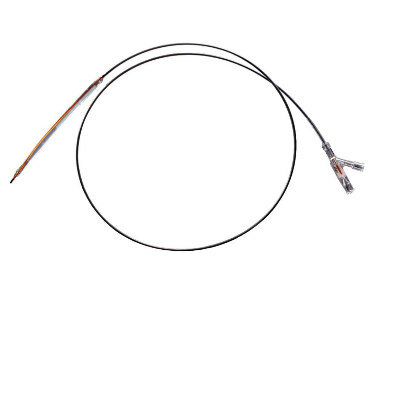Thyroidectomy Bed Drainage Timing Is Volume-Dependent
|
By HospiMedica International staff writers Posted on 20 Jan 2014 |
Surgical drains can be removed following thyroid surgery once the volume of the fluid drained is reduced and is clear, according to a new study.
Researchers at the Nagasaki University Graduate School of Biomedical Sciences (Japan) conducted a retrospective study of 249 patients who underwent thyroid surgery, in order to evaluate the chronological changes in the amount of drainage fluid and to establish standard indications for the drain to be removed. The patients were divided into four groups: a Graves’ group, a non-dissection group, a central-dissection group, and a lateral-dissection group. The amount of drainage was measured every 6 hours, and the drain was removed postoperatively when the drainage decreased in amount and contained serous fluid after a meal.
The results showed that in all four groups, the most drainage occurred in the first six hours after surgery. The total amount of drainage from the operation to the time of drain removal was significantly higher in Graves’ group and in the lateral-dissection group than in the other two groups. The median wound drainage significantly decreased from 12–18 hours after surgery in all four groups. In the lateral-dissection group, the wound drainage significantly decreased again in the first 24–30 hours. The study was published in the January 2014 issue of Surgery Today.
“The findings of this study suggest that drains can be removed postoperatively if the drainage was less than 15 mL during a 6-hour period, and contain serous fluid,” concluded lead author Shigeki Minami, MD, PhD, and colleagues of the department of surgery and the department of global health, medicine and welfare.
Although drainage of the thyroidectomy bed is not an evidenced-based practice, most surgeons still employ routine drainage with an effort to monitor postoperative bleeding. Several studies, however, have indicated that not only is it not effective in decreasing the rate of postoperative complications after thyroid surgery, it actually causes a prolonged hospital stay and may lead to surgical site infection (SSI).
Related Links:
Nagasaki University Graduate School of Biomedical Sciences
Researchers at the Nagasaki University Graduate School of Biomedical Sciences (Japan) conducted a retrospective study of 249 patients who underwent thyroid surgery, in order to evaluate the chronological changes in the amount of drainage fluid and to establish standard indications for the drain to be removed. The patients were divided into four groups: a Graves’ group, a non-dissection group, a central-dissection group, and a lateral-dissection group. The amount of drainage was measured every 6 hours, and the drain was removed postoperatively when the drainage decreased in amount and contained serous fluid after a meal.
The results showed that in all four groups, the most drainage occurred in the first six hours after surgery. The total amount of drainage from the operation to the time of drain removal was significantly higher in Graves’ group and in the lateral-dissection group than in the other two groups. The median wound drainage significantly decreased from 12–18 hours after surgery in all four groups. In the lateral-dissection group, the wound drainage significantly decreased again in the first 24–30 hours. The study was published in the January 2014 issue of Surgery Today.
“The findings of this study suggest that drains can be removed postoperatively if the drainage was less than 15 mL during a 6-hour period, and contain serous fluid,” concluded lead author Shigeki Minami, MD, PhD, and colleagues of the department of surgery and the department of global health, medicine and welfare.
Although drainage of the thyroidectomy bed is not an evidenced-based practice, most surgeons still employ routine drainage with an effort to monitor postoperative bleeding. Several studies, however, have indicated that not only is it not effective in decreasing the rate of postoperative complications after thyroid surgery, it actually causes a prolonged hospital stay and may lead to surgical site infection (SSI).
Related Links:
Nagasaki University Graduate School of Biomedical Sciences
Latest Surgical Techniques News
- Robotic Assistant Delivers Ultra-Precision Injections with Rapid Setup Times
- Minimally Invasive Endoscopic Surgery Improves Severe Stroke Outcomes
- Novel Glue Prevents Complications After Breast Cancer Surgery
- Breakthrough Brain Implant Enables Safer and More Precise Drug Delivery
- Bioadhesive Sponge Stops Uncontrolled Internal Bleeding During Surgery
- Revolutionary Nano Bone Material to Accelerate Surgery and Healing
- Superior Orthopedic Implants Combat Infections and Quicken Healing After Surgery
- Laser-Based Technique Eliminates Pancreatic Tumors While Protecting Healthy Tissue
- Surgical Treatment of Severe Carotid Artery Stenosis Benefits Blood-Brain Barrier
- Revolutionary Reusable Duodenoscope Introduces 68-Minute Sterilization
- World's First Transcatheter Smart Implant Monitors and Treats Congestion in Heart Failure
- Hybrid Endoscope Marks Breakthrough in Surgical Visualization
- Robot-Assisted Bronchoscope Diagnoses Tiniest and Hardest to Reach Lung Tumors
- Diamond-Titanium Device Paves Way for Smart Implants that Warn of Disease Progression
- 3D Printable Bio-Active Glass Could Serve as Bone Replacement Material
- Spider-Inspired Magnetic Soft Robots to Perform Minimally Invasive GI Tract Procedures
Channels
Critical Care
view channel
Ingestible Capsule Monitors Intestinal Inflammation
Acute mesenteric ischemia—a life-threatening condition caused by blocked blood flow to the intestines—remains difficult to diagnose early because its symptoms often mimic common digestive problems.... Read more
Wireless Implantable Sensor Enables Continuous Endoleak Monitoring
Endovascular aneurysm repair (EVAR) is a life-saving, minimally invasive treatment for abdominal aortic aneurysms—balloon-like bulges in the aorta that can rupture with fatal consequences.... Read more
Wearable Patch for Early Skin Cancer Detection to Reduce Unnecessary Biopsies
Skin cancer remains one of the most dangerous and common cancers worldwide, with early detection crucial for improving survival rates. Traditional diagnostic methods—visual inspections, imaging, and biopsies—can... Read morePatient Care
view channel
Revolutionary Automatic IV-Line Flushing Device to Enhance Infusion Care
More than 80% of in-hospital patients receive intravenous (IV) therapy. Every dose of IV medicine delivered in a small volume (<250 mL) infusion bag should be followed by subsequent flushing to ensure... Read more
VR Training Tool Combats Contamination of Portable Medical Equipment
Healthcare-associated infections (HAIs) impact one in every 31 patients, cause nearly 100,000 deaths each year, and cost USD 28.4 billion in direct medical expenses. Notably, up to 75% of these infections... Read more
Portable Biosensor Platform to Reduce Hospital-Acquired Infections
Approximately 4 million patients in the European Union acquire healthcare-associated infections (HAIs) or nosocomial infections each year, with around 37,000 deaths directly resulting from these infections,... Read moreFirst-Of-Its-Kind Portable Germicidal Light Technology Disinfects High-Touch Clinical Surfaces in Seconds
Reducing healthcare-acquired infections (HAIs) remains a pressing issue within global healthcare systems. In the United States alone, 1.7 million patients contract HAIs annually, leading to approximately... Read moreHealth IT
view channel
Printable Molecule-Selective Nanoparticles Enable Mass Production of Wearable Biosensors
The future of medicine is likely to focus on the personalization of healthcare—understanding exactly what an individual requires and delivering the appropriate combination of nutrients, metabolites, and... Read moreBusiness
view channel
Philips and Masimo Partner to Advance Patient Monitoring Measurement Technologies
Royal Philips (Amsterdam, Netherlands) and Masimo (Irvine, California, USA) have renewed their multi-year strategic collaboration, combining Philips’ expertise in patient monitoring with Masimo’s noninvasive... Read more
B. Braun Acquires Digital Microsurgery Company True Digital Surgery
The high-end microsurgery market in neurosurgery, spine, and ENT is undergoing a significant transformation. Traditional analog microscopes are giving way to digital exoscopes, which provide improved visualization,... Read more
CMEF 2025 to Promote Holistic and High-Quality Development of Medical and Health Industry
The 92nd China International Medical Equipment Fair (CMEF 2025) Autumn Exhibition is scheduled to be held from September 26 to 29 at the China Import and Export Fair Complex (Canton Fair Complex) in Guangzhou.... Read more













